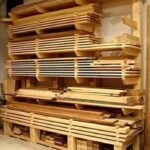Woodworking requires a variety of specialized tools, and one that holds significant importance is the mallet. Acting as the versatile workhorse of the woodshop, a well-crafted mallet is essential for various woodworking projects.
Whether you are shaping, carving, or assembling pieces, using a mallet can make all the difference in achieving precision and efficiency. In this article, we will delve into the significance of a mallet in woodworking and guide you through the process of making your very own homemade wooden mallet.
When it comes to woodworking, a mallet serves multiple purposes. Unlike hammers, which can cause damage or leave marks on delicate surfaces, a mallet provides controlled force that won’t mar the wood grain or compromise your workpiece. It is instrumental in tasks such as driving chisels for carving intricate details and joining wooden components without warping or splitting them.
While there are ready-made options available in the market, crafting your own wooden mallet offers several benefits. Not only does it allow you to customize the size and weight according to your preferences, but it also provides an opportunity to showcase your craftsmanship by creating a tool tailored to your specific needs. Additionally, making your own wooden mallet can be cost-effective compared to purchasing one from a store.
In this article, we will explore the different types of wood mallets available and their pros and cons. However, our focus will primarily be on creating a wooden mallet from scratch. By following our step-by-step instructions and tips for selecting suitable materials and tools, you’ll be able to craft a durable and efficient woodworking companion. So grab your tools and let’s embark on this exciting journey of woodworking ingenuity.
Understanding the Different Types of Wood Mallets
Woodworking requires many different tools, and one essential tool that every woodworker should have in their arsenal is a mallet. A mallet is a versatile tool that can be used for a variety of tasks, from driving chisels and carving to assembling joinery. In this section, we will explore the different types of wood mallets available, discussing their advantages and disadvantages.
There are several types of wood mallets to choose from, including nylon mallets, rubber mallets, and wooden mallets. Each type has its own unique characteristics that make it suitable for different woodworking tasks.
Nylon mallets are lightweight and designed for delicate work. They are great for tasks that require precision and where you need to avoid damaging the surface of your workpiece. However, nylon mallets may not be ideal for projects that require more force or impact.
Rubber mallets are known for their durability and shock-absorbing qualities. They are often used in situations where you need to apply some force without leaving any marks or dents on the material being worked on. Rubber mallets are commonly used in carpentry or woodworking projects where assembling joinery is required.
Wooden mallets hold a special place in the hearts of many woodworkers due to their traditional appeal and customization options. Wooden mallet heads can be made from hardwood such as oak, beech, hickory, or maple, which makes them durable and capable of handling heavy-duty tasks. The handle can also be customized to fit your personal preferences for grip size and shape.
| Type | Advantages | Disadvantages |
|---|---|---|
| Nylon Mallet | – Lightweight | – Not suitable for heavy-duty tasks |
| Rubber Mallet | – Durable and shock-absorbing | – May leave marks or dents on delicate surfaces |
| Wooden Mallet | – Durable and capable of heavy-duty tasks | – Requires woodworking skills to make |
In this blog post, we will focus on creating a wooden mallet as it offers the most customization options and allows woodworkers to showcase their craftsmanship. However, it is important to note that the choice of mallet type ultimately depends on personal preference and specific project requirements. Whether you choose a nylon, rubber, or wooden mallet, having a reliable tool like this in your workshop will greatly enhance your woodworking experience.
Tools and Materials Required for Making a Wooden Mallet
To begin your journey in crafting your own wooden mallet, it is essential to gather all the necessary tools and materials. Having the right equipment will ensure a smooth and efficient process in creating your homemade tool. Here is a comprehensive list of the tools and materials required for making a wooden mallet:
Tools
- Saw: A high-quality hand saw or power saw will be needed to cut the wood to the desired dimensions. Choose a saw that you are comfortable using and that can make precise cuts.
- Chisel: A sharp chisel is essential for carving out the handle and head of the mallet. Make sure to have different sizes of chisels available to accommodate varying shapes and designs.
- Measurement Tools: You will need measuring tools such as a ruler, tape measure, or combination square to accurately mark and measure your wood before cutting.
- Glue: Depending on your chosen joining method (glue, dowels, or screws), you may need wood glue specifically designed for woodworking projects. Look for a strong adhesive that will securely bond the handle and head of the mallet together.
- Sandpaper: Sandpaper of various grits (coarse, medium, fine) is crucial for smoothing rough edges, shaping curves, and achieving a polished finish on your wooden mallet.
- Optional Tools:
- Lathe: If you have access to a lathe, it can be used to turn the handle into a more ergonomic shape. This tool allows for greater precision in creating custom grips.
- Drill: A drill may come in handy if you choose to use dowels or screws as part of the joining method. It enables precise holes to be drilled for these fasteners.
Materials
- Wood: The type of wood you choose will greatly impact the durability and aesthetics of your mallet. Common options for mallet making include oak, beech, hickory, and maple. Select a hardwood that is readily available and suits your personal preferences.
By gathering these tools and materials, you’ll have everything needed to embark on the journey of creating your own wooden mallet. Remember to prioritize safety throughout the process by wearing protective gear such as goggles and gloves when working with sharp tools. Stay tuned for the next section where we will delve into choosing the right wood for your specific woodworking needs.
Choosing the Right Wood for Your Mallet
When it comes to making a wooden mallet, choosing the right type of wood is crucial. The wood you select will determine the durability, strength, and overall quality of your mallet. Here are some common types of wood that are suitable for crafting a mallet:
- Oak: Known for its strength and durability, oak is an excellent choice for a wooden mallet. It can withstand heavy pounding and provides excellent shock resistance. Additionally, oak has an attractive grain pattern that adds to the aesthetic appeal of the mallet.
- Beech: Beech is another popular choice for woodworking tools due to its hardness and shock-absorbing properties. It is also readily available and affordable, making it a practical option for crafting a mallet.
- Hickory: Hickory wood is renowned for its exceptional strength and stiffness, making it ideal for heavy-duty applications. Its natural resistance to wear and tear ensures that your mallet will last for years without losing its effectiveness.
- Maple: Maple wood is known for its fine grain and excellent stability, providing a sturdy base for your wooden mallet. It is less prone to splitting or warping compared to other types of wood, ensuring longevity in your woodworking projects.
When selecting the ideal wood type for your mallet, consider factors such as availability, budget, desired weight balance, and personal preference. It’s essential to choose a dense hardwood that can endure the demands of woodworking while maintaining comfort during use.
Before starting your project, ensure that your chosen wood has been properly dried or seasoned to prevent any potential issues in the future.
By carefully selecting the right wood for your homemade mallet, you can create a tool that not only performs well but also showcases the natural beauty of woodworking craftsmanship.
Tips on Selecting Wood
- Consider the density and hardness of the wood to ensure it can withstand heavy-duty use.
- Choose a wood type that has an appealing grain pattern if aesthetics are important to you.
- Check the moisture content of the wood to avoid any potential issues in the future – aim for a moisture content between 6% and 8%.
- Consider the weight of the wood and select one that feels comfortable for your woodworking needs.
Step-by-Step Instructions
Now that you understand the importance of a wooden mallet in woodworking and have gathered all the necessary tools and materials, it’s time to dive into the step-by-step process of creating your own wooden mallet.
a. Selecting the appropriate wood size and dimensions:
- Measure and mark the desired length for your mallet handle, usually around 10-12 inches.
- Decide on the size of the mallet head based on your preference and intended use.
- Keep in mind that a larger head will provide more striking power, while a smaller one offers better control.
b. Marking and cutting the wood to the desired shape:
- Use a pencil or marking knife to outline the shape of your mallet head.
- Use a saw to cut along these markings, ensuring clean and straight cuts.
c. Carving the handle and head of the mallet:
- If desired, use a lathe or chisel to shape the handle into your preferred design (e.g., cylindrical or tapered).
- Consider ergonomics when shaping the handle to ensure a comfortable grip during prolonged use.
- Carve out any decorative details on both the handle and head, if desired.
d. Joining the handle and head using a suitable method:
- Apply wood glue on both ends of the handle where it will connect with the mallet head.
- Insert dowels into pre-drilled holes for added stability. Alternatively, you can attach them using screws.
e. Sanding and finishing touches to ensure a smooth and comfortable grip:
- Use sandpaper or an electric sander to sand down any rough edges or imperfections on both the handle and head.
- Pay extra attention to smoothing out all surfaces that will come into contact with your hand for optimal comfort.
- Apply a coat of wood finish or varnish to protect the mallet from moisture and enhance its appearance.
Throughout each step, it’s important to take your time and ensure accuracy to create a high-quality wooden mallet that will serve you well in various woodworking projects. The process may require some patience and practice, especially for beginners, but the end result is well worth it.
Advanced Techniques and Customizations for Your Mallet
Enhancing Functionality and Aesthetics
Once you have mastered the basic steps of crafting a wooden mallet, you can experiment with advanced techniques and customizations to further enhance its functionality and aesthetics. These additional touches not only make your mallet unique but also allow you to personalize it according to your preferences. Here are some ideas to take your homemade mallet to the next level:
Decorative Details
Consider adding decorative details to your mallet to make it stand out. You can achieve this by incorporating carved patterns or shapes on the handle or head of the mallet. Intricate designs or symbols can elevate the visual appeal of your mallet and make it a conversation piece in your workshop.
Personalization
Personalize your mallet by adding engravings or inlays that hold special meaning for you. You can engrave your initials, name, or even a favorite quote onto the handle or head of the mallet. This personal touch adds sentiment and makes it truly yours.
Alternative Handle Shapes
While traditional cylindrical handles are popular, experimenting with alternative handle shapes can provide better maneuverability and comfort during use. Consider crafting a tapered or ergonomic handle that fits naturally in your hand, reducing fatigue and improving control.
Maintenance and Care Tips for Your Homemade Mallet
Taking proper care of your homemade wooden mallet is crucial for ensuring its longevity and performance throughout years of woodworking projects. Here are some essential maintenance and care tips to keep in mind:
Regular Cleaning
After each use, wipe down the mallet with a damp cloth to remove any sawdust or debris that may have accumulated on its surface. Keeping it clean prevents dust particles from scratching the wood over time.
Preventing Damage
Avoid using your mallet on metal surfaces or striking hard objects that can cause damage to the mallet’s head or handle. Additionally, store the mallet in a dry place away from extreme temperatures or moisture to prevent warping.
Handling Repairs
If you notice any cracks, splits, or loose components in your mallet, it is essential to address these issues promptly. Use wood glue to mend any cracks and tighten any loose joints. Allow the glue to dry fully before using the mallet again.
By incorporating advanced techniques and personalizing your mallet, you can create a woodworking tool that not only functions exceptionally but also reflects your creativity and craftsmanship. With proper maintenance and care, your homemade mallet will be a trusted companion in all your woodworking endeavors for years to come.
Maintenance and Care Tips for Your Homemade Mallet
Preserving the Longevity of Your Homemade Mallet
Once you have successfully crafted your own wooden mallet, it is important to take proper care of it to ensure its longevity and optimal performance. By following a few maintenance tips, you can keep your homemade mallet in excellent condition for years to come.
To start, always store your mallet in a dry place to prevent moisture from affecting the wood. Moisture can lead to warping or splitting, which can significantly reduce the effectiveness of your mallet. Additionally, it is advisable to avoid exposing your mallet to extreme temperature changes or direct sunlight, as these factors can also cause damage over time.
Keeping Your Mallet Clean
Regular cleaning is essential for maintaining the quality of your homemade mallet. After each use, remove any debris or sawdust that may have accumulated on the surface of the mallet head or handle. This can be done by using a soft brush or cloth. Avoid using water unless absolutely necessary, as excessive moisture can compromise the integrity of the wood.
If you find that your mallet requires a deeper clean, use a mild soap solution and damp cloth to gently wipe away any dirt or stains. Be sure to dry the mallet thoroughly after cleaning to prevent any moisture from remaining on the surface.
Handling Repairs
Over time, even with proper care, your homemade mallet may require repairs. If you notice any cracks or splits in the wood, it is important to address them promptly before they worsen.
For minor cracks or splits, applying wood glue along the damaged area and clamping it until dry should suffice. However, if the damage is more severe or affects the overall functionality of the mallet, you may need to consider replacing certain parts or seeking professional assistance.
By following these maintenance and care tips for your homemade mallet, you can ensure that it remains in great condition and continues to serve you effectively in your woodworking endeavors. Taking the time to care for your mallet will preserve its craftsmanship and allow you to enjoy the benefits of this versatile tool for a long time.
Conclusion
In conclusion, the process of making a homemade wooden mallet not only provides you with a versatile tool for your woodworking projects but also celebrates the craftsmanship and creativity that goes into creating your own tools. By following the step-by-step instructions outlined in this article, you have the opportunity to personalize your mallet and make it truly unique to your woodworking needs.
One of the main advantages of crafting your own wooden mallet is the ability to choose and work with high-quality materials. By selecting the right type of wood for your mallet, such as oak, beech, hickory, or maple, you can ensure that it is durable and long-lasting. Additionally, by adding customizations like decorative details or personalized engravings, you can create a mallet that reflects your own style and personality.
Furthermore, embracing your woodworking skills and exploring other homemade tool possibilities opens up a world of possibilities for creativity and self-expression. As you continue to develop your woodworking abilities, you may find yourself discovering new techniques and designs that enhance both the functionality and aesthetics of your homemade tools.
Frequently Asked Questions
How do you make a woodworker mallet?
To make a woodworker mallet, you will need a suitable wood for the head and handle. Start by selecting a dense hardwood like maple, beech, or oak for durability and strength. Determine the desired size of your mallet head based on personal preference and the type of woodworking tasks you plan to undertake. Cut the wood to the appropriate length and shape it into a rectangular block, tapering one end to form the striking face.
Sand and smooth all surfaces to ensure comfort and ease of use. Next, shape the handle from another piece of hardwood by cutting it to a suitable length and carving it into a cylindrical or octagonal shape for optimal grip. Securely attach the handle to the mallet head using dowels or epoxy, ensuring a sturdy connection. Finally, apply a protective finish such as oil or wax to enhance durability and bring out the natural beauty of the wood.
What is the best material for a wooden mallet?
When selecting material for a wooden mallet, there are several factors to consider in order to determine the best choice. One primary consideration is density – it is crucial that the material is hard enough to withstand repeated blows without denting or deforming easily. Dense hardwoods such as maple, hickory, or lignum vitae are commonly used in making high-quality wooden mallets due to their excellent resistance to wear and impact.
These types of wood provide an ideal balance of hardness and durability while offering enough weight for effective striking force. Additionally, selecting a hardwood with a tight grain pattern helps minimize splitting or cracking during use.
How thick should a mallet be?
The thickness of a mallet largely depends on personal preference and intended usage. However, there are some general guidelines that can be considered when determining an appropriate thickness for a wooden mallet head. Thicker heads tend to be more robust and capable of delivering greater striking force without risk of splitting or breaking apart during use.
For heavy-duty woodworking tasks that require significant impact force, mallet heads between 2 to 3 inches thick can provide optimal strength and durability. However, for more delicate tasks or if a lighter touch is desired, a thinner mallet head between 1.5 to 2 inches thick may be more suitable. Ultimately, it is important to choose a thickness that feels comfortable in your hand and provides the necessary power and control for the woodworking applications you intend to undertake.

Hi everyone! I’m a woodworker and blogger, and this is my woodworking blog. In my blog, I share tips and tricks for woodworkers of all skill levels, as well as project ideas that you can try yourself.





